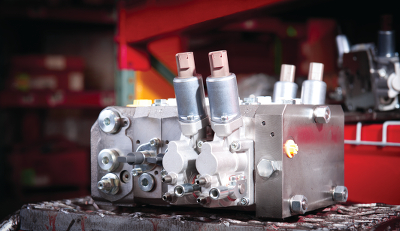You Don't have to Sacrifice Efficiency for Complexity
Featured in Muncie Power Quarterly, Issue 3, 2017
In markets like refuse or snow and ice, where applications can be complex and require multiple functions at one time, it can be difficult to balance system complexity with efficiency. With the release of Muncie Power Products' new L125 Series sectional, load-sense valve in the second quarter however, the company now offers its own option so that efficiency nor complexity need be sacrificed.
As a member of the team working on bringing this product to market, Product and Applications Engineer Nick Schmidt sees the product as an opportunity for the company’s customers to achieve a more efficient, hydraulic system.
 “It gives you the opportunity to have a more efficient system because when your valve is not stroked, as long as your system is set up right, the pump won’t be trying to send oil to the valve—which is inefficient,” he explained.
“It gives you the opportunity to have a more efficient system because when your valve is not stroked, as long as your system is set up right, the pump won’t be trying to send oil to the valve—which is inefficient,” he explained.
In order to create the L125 Series and provide this opportunity, the team had to reflect on previous load-sense products once distributed by the company and leverage its relationship with the Interpump Group to offer an Interpump load-sense product.
“To develop what we were going to offer we evaluated previous usage of load-sense products here at Muncie Power and built our product portfolio based off that,” said Nick.
Compared to Muncie Power's other valves, the L125 Series is similar in that it is a valve but also very different from the V Series directional control valves. According to Nick, the L125 Series differs from the V Series as it is load sensing, has a closed center and features good flow sharing capabilities.
“Because it’s post-compensated, the flow sharing characteristics are quite good,” he said.
Post-compensated means that the valve can distribute flow to multiple work sections at the same time. Additionally, the system communicates hydraulically by sending a pressure signal back to the pump to adjust the pump’s flow so that the multiple functions operate efficiently. As Nick shared, with a standard, open-center valve there is typically no compensation—which means that it cannot operate multiple functions simultaneously and it does not tell the pump how much flow it needs.
Well suited for applications within the agriculture, utility, snow and ice, and refuse markets where multiple functions are more likely required, the L125 Series ultimately meets two main needs identified within these markets.
“Two main reasons would be operating multiple functions at the same time or wanting a more efficient system,” he said.
The L125 Series has a 33 GPM nominal flow rate with an inlet capable of a maximum of 40 GPM and its work sections a maximum of 26.4 GPM. Beyond its good flow sharing capabilities mentioned, the L125 Series also has multiple spool flow options and both electro-hydraulic and manual shift versions available.
Muncie Power’s L125 Series covers lower flow rates, which is why the company has plans to—as Nick said—soon “offer its big brother, the L275 Series.” This larger valve will have higher flow rates, so that the entire flow range from low to high is covered.
For customers, the L125 Series means Muncie Power offers an option, and the opportunity, to capitalize on efficiency while operating multiple functions.


